Time-dependent quasi-Hermitian Hamiltonians and the unitarity of quantum evolution
- 格式:pdf
- 大小:148.80 KB
- 文档页数:10
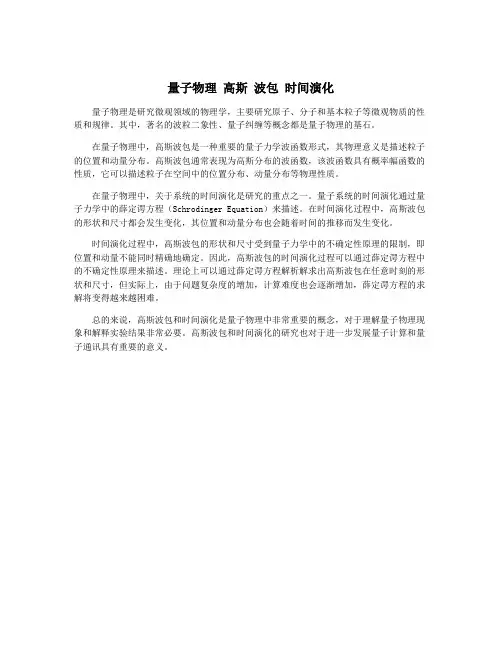
量子物理高斯波包时间演化
量子物理是研究微观领域的物理学,主要研究原子、分子和基本粒子等微观物质的性质和规律。
其中,著名的波粒二象性、量子纠缠等概念都是量子物理的基石。
在量子物理中,高斯波包是一种重要的量子力学波函数形式,其物理意义是描述粒子的位置和动量分布。
高斯波包通常表现为高斯分布的波函数,该波函数具有概率幅函数的性质,它可以描述粒子在空间中的位置分布、动量分布等物理性质。
在量子物理中,关于系统的时间演化是研究的重点之一。
量子系统的时间演化通过量子力学中的薛定谔方程(Schrodinger Equation)来描述。
在时间演化过程中,高斯波包的形状和尺寸都会发生变化,其位置和动量分布也会随着时间的推移而发生变化。
时间演化过程中,高斯波包的形状和尺寸受到量子力学中的不确定性原理的限制,即位置和动量不能同时精确地确定。
因此,高斯波包的时间演化过程可以通过薛定谔方程中的不确定性原理来描述。
理论上可以通过薛定谔方程解析解求出高斯波包在任意时刻的形状和尺寸,但实际上,由于问题复杂度的增加,计算难度也会逐渐增加,薛定谔方程的求解将变得越来越困难。
总的来说,高斯波包和时间演化是量子物理中非常重要的概念,对于理解量子物理现象和解释实验结果非常必要。
高斯波包和时间演化的研究也对于进一步发展量子计算和量子通讯具有重要的意义。
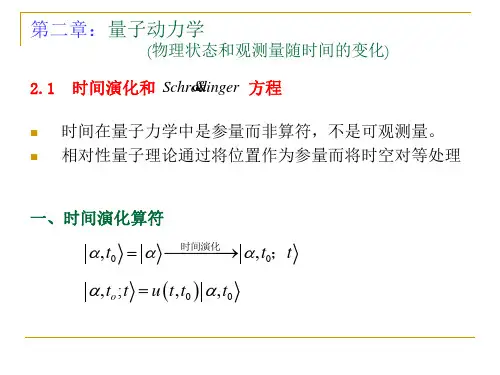
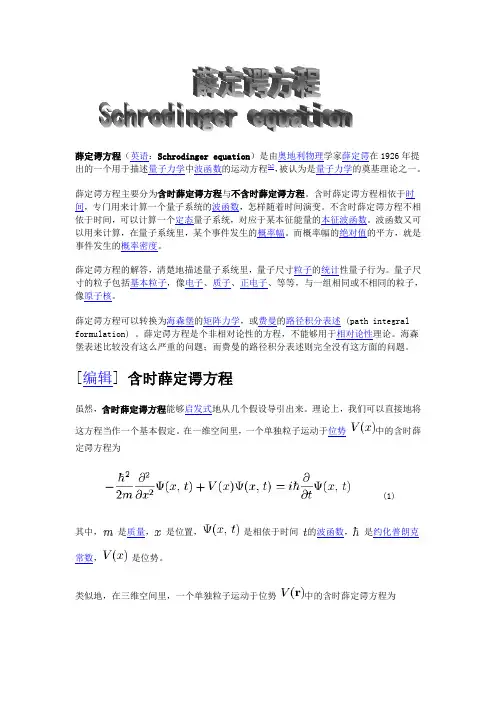
薛定谔方程(英语:Schrodinger equation)是由奥地利物理学家薛定谔在1926年提出的一个用于描述量子力学中波函数的运动方程[1],被认为是量子力学的奠基理论之一。
薛定谔方程主要分为含时薛定谔方程与不含时薛定谔方程。
含时薛定谔方程相依于时间,专门用来计算一个量子系统的波函数,怎样随着时间演变。
不含时薛定谔方程不相依于时间,可以计算一个定态量子系统,对应于某本征能量的本征波函数。
波函数又可以用来计算,在量子系统里,某个事件发生的概率幅。
而概率幅的绝对值的平方,就是事件发生的概率密度。
薛定谔方程的解答,清楚地描述量子系统里,量子尺寸粒子的统计性量子行为。
量子尺寸的粒子包括基本粒子,像电子、质子、正电子、等等,与一组相同或不相同的粒子,像原子核。
薛定谔方程可以转换为海森堡的矩阵力学,或费曼的路径积分表述 (path integral formulation) 。
薛定谔方程是个非相对论性的方程,不能够用于相对论性理论。
海森堡表述比较没有这么严重的问题;而费曼的路径积分表述则完全没有这方面的问题。
[编辑]含时薛定谔方程虽然,含时薛定谔方程能够启发式地从几个假设导引出来。
理论上,我们可以直接地将这方程当作一个基本假定。
在一维空间里,一个单独粒子运动于位势中的含时薛定谔方程为(1)其中,是质量,是位置,是相依于时间的波函数,是约化普朗克常数,是位势。
类似地,在三维空间里,一个单独粒子运动于位势中的含时薛定谔方程为(2)假若,系统内有个粒子,则波函数是定义于-位形空间,所有可能的粒子位置空间。
用方程表达,。
其中,波函数的第个参数是第个粒子的位置。
所以,第个粒子的位置是。
[编辑]不含时薛定谔方程不含时薛定谔方程不相依于时间,又称为本征能量薛定谔方程,或定态薛定谔方程。
顾名思义,本征能量薛定谔方程,可以用来计算粒子的本征能量与其它相关的量子性质。
应用分离变量法,猜想的函数形式为;其中,是分离常数,是对应于的函数.稍回儿,我们会察觉就是能量.代入这猜想解,经过一番运算,含时薛定谔方程 (1) 会变为不含时薛定谔方程:。
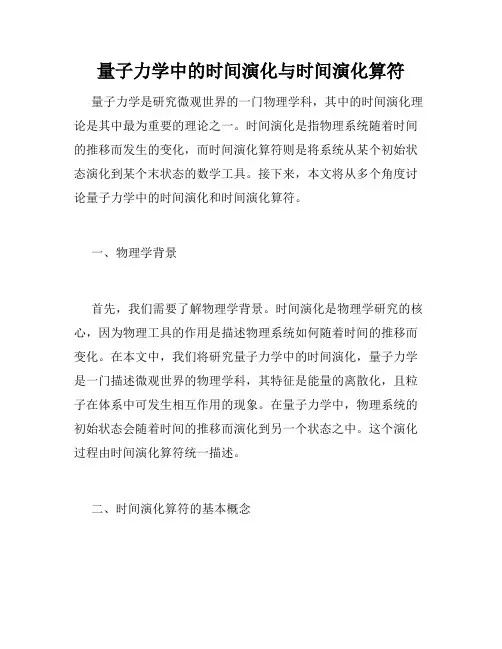
量子力学中的时间演化与时间演化算符量子力学是研究微观世界的一门物理学科,其中的时间演化理论是其中最为重要的理论之一。
时间演化是指物理系统随着时间的推移而发生的变化,而时间演化算符则是将系统从某个初始状态演化到某个末状态的数学工具。
接下来,本文将从多个角度讨论量子力学中的时间演化和时间演化算符。
一、物理学背景首先,我们需要了解物理学背景。
时间演化是物理学研究的核心,因为物理工具的作用是描述物理系统如何随着时间的推移而变化。
在本文中,我们将研究量子力学中的时间演化,量子力学是一门描述微观世界的物理学科,其特征是能量的离散化,且粒子在体系中可发生相互作用的现象。
在量子力学中,物理系统的初始状态会随着时间的推移而演化到另一个状态之中。
这个演化过程由时间演化算符统一描述。
二、时间演化算符的基本概念时间演化是描述量子系统演化的核心理论,而时间演化算符则是实现时间演化的数学工具。
时间演化算符通常用U(t)表示,表示的是时间t内的演化过程。
另外,时间演化算符还有一个十分重要的性质,就是它是幺正的。
幺正性质是指时间演化算符将物理系统的本征状态保持不变,这意味着时间演化算符可以确保在任何时候都能保持系统的物理状态不变。
三、时间演化逆算符时间演化逆算符是时间演化算符的逆运算,它通常用U(t)的逆元U^(-1)(t)来表示。
U(t)的逆元的性质是U(t)U^(-1)(t)=U^(-1)(t)U(t)=1,即两者乘起来的结果是一个单位矩阵。
这意味着如果时间演化算符可以将系统演化成一个特定的状态,那么时间演化逆算符则会将系统从该状态回推到初始状态。
四、时间演化算符的方程时间演化算符是实现时间演化的数学工具,因此,我们需要一个数学工具来描述时间演化算符本身的性质。
这个数学工具就是时间演化算符的方程,通常称为薛定谔方程。
薛定谔方程的核心是哈密顿算符,它描述了物理系统的性质和演化规律。
薛定谔方程的一般形式为:IHΨ(x, t)=HΨ(x, t)其中,Ψ(x, t)是系统的波函数,H是哈密顿算符,I是单位矩阵。
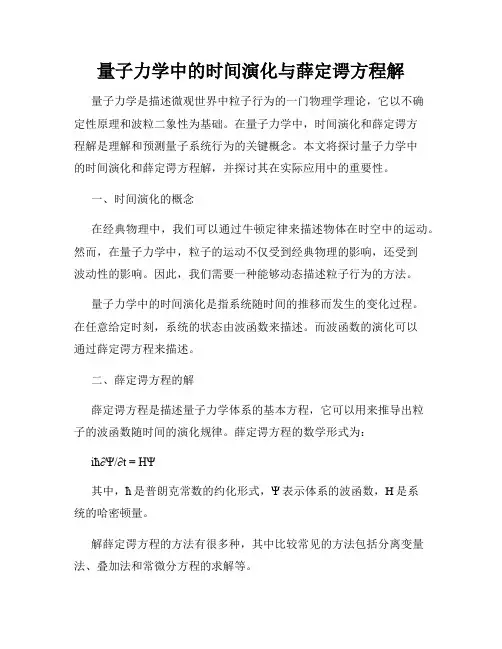
量子力学中的时间演化与薛定谔方程解量子力学是描述微观世界中粒子行为的一门物理学理论,它以不确定性原理和波粒二象性为基础。
在量子力学中,时间演化和薛定谔方程解是理解和预测量子系统行为的关键概念。
本文将探讨量子力学中的时间演化和薛定谔方程解,并探讨其在实际应用中的重要性。
一、时间演化的概念在经典物理中,我们可以通过牛顿定律来描述物体在时空中的运动。
然而,在量子力学中,粒子的运动不仅受到经典物理的影响,还受到波动性的影响。
因此,我们需要一种能够动态描述粒子行为的方法。
量子力学中的时间演化是指系统随时间的推移而发生的变化过程。
在任意给定时刻,系统的状态由波函数来描述。
而波函数的演化可以通过薛定谔方程来描述。
二、薛定谔方程的解薛定谔方程是描述量子力学体系的基本方程,它可以用来推导出粒子的波函数随时间的演化规律。
薛定谔方程的数学形式为:iħ∂Ψ/∂t = HΨ其中,ħ是普朗克常数的约化形式,Ψ表示体系的波函数,H是系统的哈密顿量。
解薛定谔方程的方法有很多种,其中比较常见的方法包括分离变量法、叠加法和常微分方程的求解等。
三、时间演化算符在量子力学中,我们通过时间演化算符来表示体系在任意时刻的状态与初始状态之间的关系。
时间演化算符由薛定谔方程的解决定,它可以通过波函数的时间演化表示为:Ψ(t) = U(t, t0)Ψ(t0)其中,Ψ(t0)表示初始状态的波函数,Ψ(t)表示在时间t时刻的波函数。
U(t, t0)则是时间演化算符,它是由薛定谔方程的解构成。
时间演化算符具有线性性质,且满足合成性原理。
这意味着如果我们将体系的时间演化分为若干个小步骤,那么整个体系的时间演化可以由这些小步骤的时间演化算符进行叠加得到。
四、应用和意义薛定谔方程的解和时间演化在量子力学中有着广泛的应用和重要的意义。
首先,它们可以用来解释和预测实验现象。
例如,通过求解薛定谔方程,我们可以预测某个粒子在某一特定势场中的行为,从而验证实验结果。
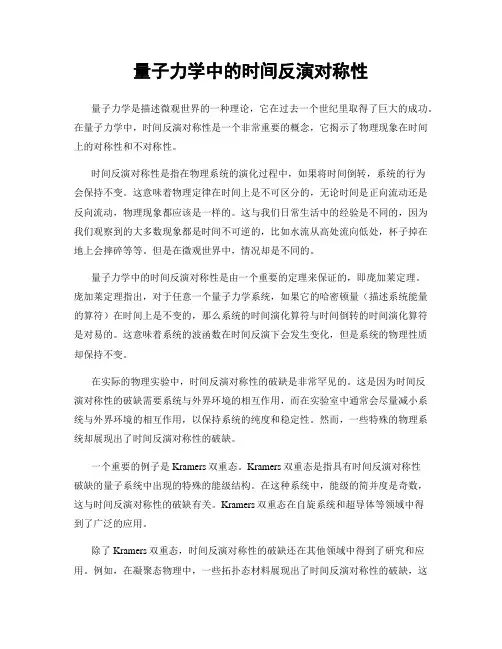
量子力学中的时间反演对称性量子力学是描述微观世界的一种理论,它在过去一个世纪里取得了巨大的成功。
在量子力学中,时间反演对称性是一个非常重要的概念,它揭示了物理现象在时间上的对称性和不对称性。
时间反演对称性是指在物理系统的演化过程中,如果将时间倒转,系统的行为会保持不变。
这意味着物理定律在时间上是不可区分的,无论时间是正向流动还是反向流动,物理现象都应该是一样的。
这与我们日常生活中的经验是不同的,因为我们观察到的大多数现象都是时间不可逆的,比如水流从高处流向低处,杯子掉在地上会摔碎等等。
但是在微观世界中,情况却是不同的。
量子力学中的时间反演对称性是由一个重要的定理来保证的,即庞加莱定理。
庞加莱定理指出,对于任意一个量子力学系统,如果它的哈密顿量(描述系统能量的算符)在时间上是不变的,那么系统的时间演化算符与时间倒转的时间演化算符是对易的。
这意味着系统的波函数在时间反演下会发生变化,但是系统的物理性质却保持不变。
在实际的物理实验中,时间反演对称性的破缺是非常罕见的。
这是因为时间反演对称性的破缺需要系统与外界环境的相互作用,而在实验室中通常会尽量减小系统与外界环境的相互作用,以保持系统的纯度和稳定性。
然而,一些特殊的物理系统却展现出了时间反演对称性的破缺。
一个重要的例子是Kramers双重态。
Kramers双重态是指具有时间反演对称性破缺的量子系统中出现的特殊的能级结构。
在这种系统中,能级的简并度是奇数,这与时间反演对称性的破缺有关。
Kramers双重态在自旋系统和超导体等领域中得到了广泛的应用。
除了Kramers双重态,时间反演对称性的破缺还在其他领域中得到了研究和应用。
例如,在凝聚态物理中,一些拓扑态材料展现出了时间反演对称性的破缺,这导致了一些奇特的物理现象,比如量子反常霍尔效应和拓扑绝缘体等。
这些现象的研究不仅对理解基础物理现象有重要意义,还有望在量子计算和量子通信等领域中发挥重要作用。
尽管时间反演对称性在量子力学中具有重要的地位,但是它并不是绝对的。
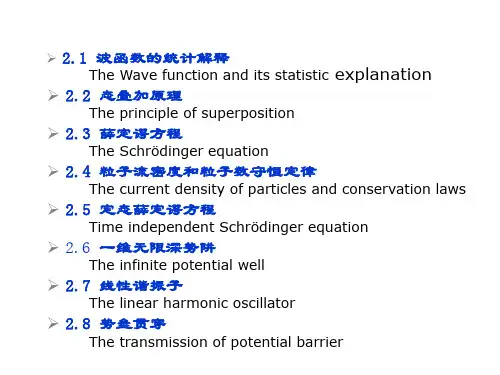
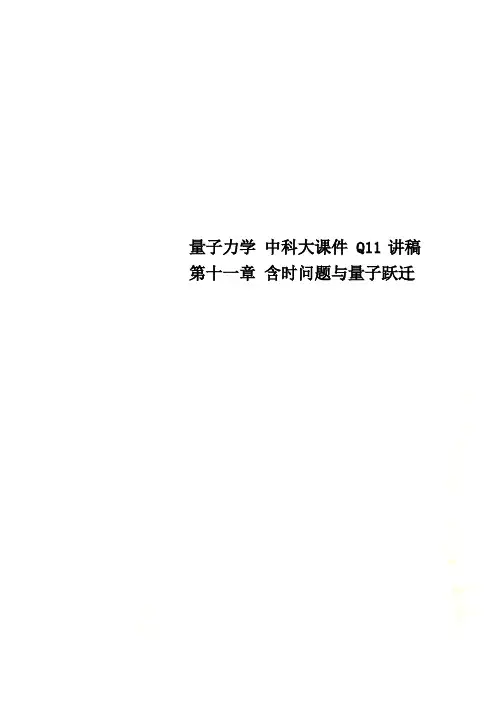
量子力学中科大课件 Q11讲稿第十一章含时问题与量子跃迁第三部分开放体系问题第十一章含时问题与量子跃迁本章讨论量子力学中的时间相关现象。
它们包括:含时问题求解的一般讨论、含时微扰论、量子跃迁也即辐射的发射和吸收问题。
如果说,以前各章主要研究量子力学中的稳态问题,本章则专门讨论非稳态问题。
根据第五章中有关叙述,由于我们所处时空结构的时间轴固有的均匀性,孤立量子体系的Hamilton量必定不显含时间,从而遵守不显含时间的Schrödinger方程。
因此,这里含时Schrödinger方程所表述的量子体系必定不是孤立的量子体系,而是某个更大的可以看作孤立系的一部分,是这个孤立系的一个子体系。
当这个子体系和孤立系的其他部分存在着能量、动量、角动量、甚至电荷或粒子的交换时,便导致针对这个子体系的各类含时问题。
在了解本章(以及下一章)内容的时候,有时需要注意这一点。
§11.1 含时Schrödinger方程求解的一般讨论1, 时间相关问题的一般分析量子力学中,时间相关问题可以分为两类:i, 体系的Hamilton量不依赖于时间。
这时,要么是散射或行进问题,要么是初始条件或边界条件的变化使问题成为与时间相关的现象。
“行进问题”例如,中子以一定的自旋取向进入一均匀磁场并穿出,这是一个自旋沿磁场方向进动的时间相关问题;258259“初始条件问题”比如,波包的自由演化,这是一个与时间相关的波包弥散问题。
更一般地说,初态引起的含时问题可以表述为:由于Hamilton 量中的某种相互作用导致体系初态的不稳定。
例如Hamilton 量中的弱相互作用导致初态粒子的β 衰变等;最后,“边界条件变动”也能使问题成为一个与时间相关的现象。
例如阱壁位置随时间变动或振荡的势阱问题等。
ii, 体系的Hamilton 量依赖于时间。
这比如,频率调制的谐振子问题或是时间相关受迫谐振子问题,交变外电磁场下原子中电子的状态跃迁问题等等。
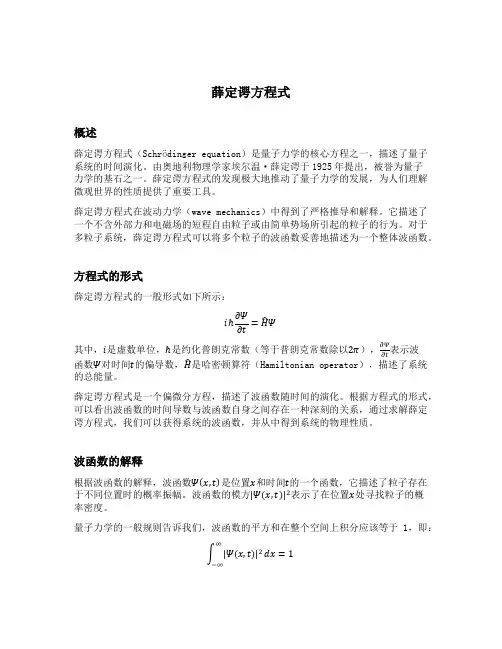
薛定谔方程式概述薛定谔方程式(Schrödinger equation)是量子力学的核心方程之一,描述了量子系统的时间演化。
由奥地利物理学家埃尔温·薛定谔于1925年提出,被誉为量子力学的基石之一。
薛定谔方程式的发现极大地推动了量子力学的发展,为人们理解微观世界的性质提供了重要工具。
薛定谔方程式在波动力学(wave mechanics)中得到了严格推导和解释。
它描述了一个不含外部力和电磁场的短程自由粒子或由简单势场所引起的粒子的行为。
对于多粒子系统,薛定谔方程式可以将多个粒子的波函数妥善地描述为一个整体波函数。
方程式的形式薛定谔方程式的一般形式如下所示:iℏ∂Ψ∂t=ĤΨ其中,i是虚数单位,ℏ是约化普朗克常数(等于普朗克常数除以2π),∂Ψ∂t表示波函数Ψ对时间t的偏导数,Ĥ是哈密顿算符(Hamiltonian operator),描述了系统的总能量。
薛定谔方程式是一个偏微分方程,描述了波函数随时间的演化。
根据方程式的形式,可以看出波函数的时间导数与波函数自身之间存在一种深刻的关系,通过求解薛定谔方程式,我们可以获得系统的波函数,并从中得到系统的物理性质。
波函数的解释根据波函数的解释,波函数Ψ(x,t)是位置x和时间t的一个函数,它描述了粒子存在于不同位置时的概率振幅。
波函数的模方|Ψ(x,t)|2表示了在位置x处寻找粒子的概率密度。
量子力学的一般规则告诉我们,波函数的平方和在整个空间上积分应该等于1,即:∫|Ψ(x,t)|2∞−∞dx=1这表示粒子总是处于一定的状态中,而且它的位置在真实性上是不确定的,只有一定的概率存在于某个特定位置。
哈密顿算符在薛定谔方程式中,哈密顿算符Ĥ起着关键的作用,它对应着系统的总能量。
哈密顿算符的具体形式取决于所研究的系统的性质。
对于一个自由粒子,哈密顿算符可以写为:Ĥ=−ℏ22m∂2∂x2其中,m是粒子的质量。
对于一个粒子受势场影响的情况,哈密顿算符则需要加入相应的势能项。
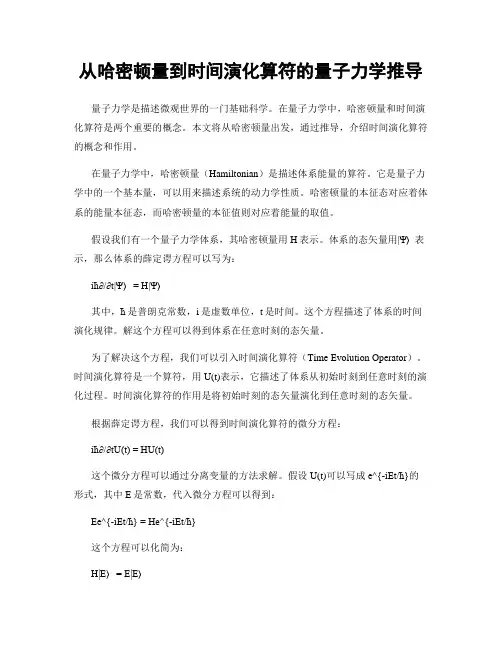
从哈密顿量到时间演化算符的量子力学推导量子力学是描述微观世界的一门基础科学。
在量子力学中,哈密顿量和时间演化算符是两个重要的概念。
本文将从哈密顿量出发,通过推导,介绍时间演化算符的概念和作用。
在量子力学中,哈密顿量(Hamiltonian)是描述体系能量的算符。
它是量子力学中的一个基本量,可以用来描述系统的动力学性质。
哈密顿量的本征态对应着体系的能量本征态,而哈密顿量的本征值则对应着能量的取值。
假设我们有一个量子力学体系,其哈密顿量用H表示。
体系的态矢量用|Ψ⟩表示,那么体系的薛定谔方程可以写为:iħ∂/∂t|Ψ⟩= H|Ψ⟩其中,ħ是普朗克常数,i是虚数单位,t是时间。
这个方程描述了体系的时间演化规律。
解这个方程可以得到体系在任意时刻的态矢量。
为了解决这个方程,我们可以引入时间演化算符(Time Evolution Operator)。
时间演化算符是一个算符,用U(t)表示,它描述了体系从初始时刻到任意时刻的演化过程。
时间演化算符的作用是将初始时刻的态矢量演化到任意时刻的态矢量。
根据薛定谔方程,我们可以得到时间演化算符的微分方程:iħ∂/∂tU(t) = HU(t)这个微分方程可以通过分离变量的方法求解。
假设U(t)可以写成e^{-iEt/ħ}的形式,其中E是常数,代入微分方程可以得到:Ee^{-iEt/ħ} = He^{-iEt/ħ}这个方程可以化简为:H|E⟩ = E|E⟩这个方程的解就是哈密顿量的本征态和本征值。
因此,时间演化算符可以表示为:U(t) = ∑ e^{-iEt/ħ}|E⟩⟨E|其中,∑表示对所有本征态求和。
通过时间演化算符,我们可以得到体系在任意时刻的态矢量。
假设初始时刻的态矢量为|Ψ(0)⟩,那么在任意时刻t的态矢量可以表示为:|Ψ(t)⟩ = U(t)|Ψ(0)⟩这个式子描述了体系的时间演化过程。
通过求解哈密顿量的本征值和本征态,我们可以得到体系在任意时刻的态矢量。
总结起来,从哈密顿量到时间演化算符的量子力学推导可以分为以下几个步骤:首先,根据薛定谔方程,得到时间演化算符的微分方程;然后,通过求解哈密顿量的本征值和本征态,得到时间演化算符的表达式;最后,利用时间演化算符,可以得到体系在任意时刻的态矢量。
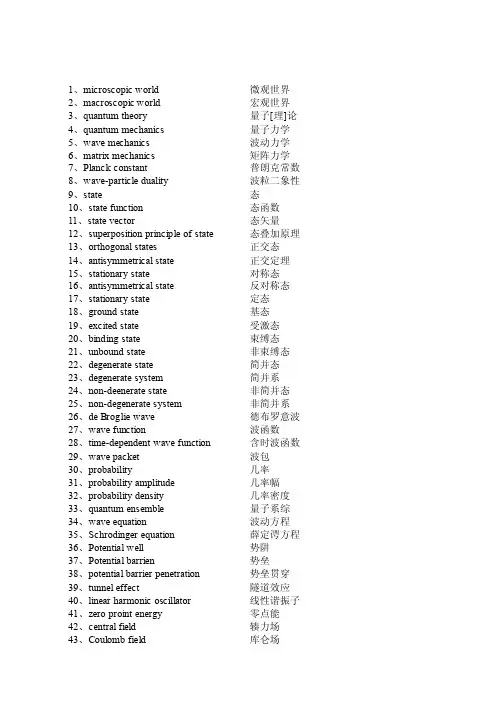
1、microscopic world 微观世界2、macroscopic world 宏观世界3、quantum theory 量子[理]论4、quantum mechanics 量子力学5、wave mechanics 波动力学6、matrix mechanics 矩阵力学7、Planck constant 普朗克常数8、wave-particle duality 波粒二象性9、state 态10、state function 态函数11、state vector 态矢量12、superposition principle of state 态叠加原理13、orthogonal states 正交态14、antisymmetrical state 正交定理15、stationary state 对称态16、antisymmetrical state 反对称态17、stationary state 定态18、ground state 基态19、excited state 受激态20、binding state 束缚态21、unbound state 非束缚态22、degenerate state 简并态23、degenerate system 简并系24、non-deenerate state 非简并态25、non-degenerate system 非简并系26、de Broglie wave 德布罗意波27、wave function 波函数28、time-dependent wave function 含时波函数29、wave packet 波包30、probability 几率31、probability amplitude 几率幅32、probability density 几率密度33、quantum ensemble 量子系综34、wave equation 波动方程35、Schrodinger equation 薛定谔方程36、Potential well 势阱37、Potential barrien 势垒38、potential barrier penetration 势垒贯穿39、tunnel effect 隧道效应40、linear harmonic oscillator线性谐振子41、zero proint energy 零点能42、central field 辏力场43、Coulomb field 库仑场44、δ-function δ-函数45、operator 算符46、commuting operators 对易算符47、anticommuting operators 反对易算符48、complex conjugate operator 复共轭算符49、Hermitian conjugate operator 厄米共轭算符50、Hermitian operator 厄米算符51、momentum operator 动量算符52、energy operator 能量算符53、Hamiltonian operator 哈密顿算符54、angular momentum operator 角动量算符55、spin operator 自旋算符56、eigen value 本征值57、secular equation 久期方程58、observable 可观察量59、orthogonality 正交性60、completeness 完全性61、closure property 封闭性62、normalization 归一化63、orthonormalized functions 正交归一化函数64、quantum number 量子数65、principal quantum number 主量子数66、radial quantum number 径向量子数67、angular quantum number 角量子数68、magnetic quantum number 磁量子数69、uncertainty relation 测不准关系70、principle of complementarity 并协原理71、quantum Poisson bracket 量子泊松括号72、representation 表象73、coordinate representation 坐标表象74、momentum representation 动量表象75、energy representation 能量表象76、Schrodinger representation 薛定谔表象77、Heisenberg representation 海森伯表象78、interaction representation 相互作用表象79、occupation number representation 粒子数表象80、Dirac symbol 狄拉克符号81、ket vector 右矢量82、bra vector 左矢量83、basis vector 基矢量84、basis ket 基右矢85、basis bra 基左矢86、orthogonal kets 正交右矢87、orthogonal bras 正交左矢88、symmetrical kets 对称右矢89、antisymmetrical kets 反对称右矢90、Hilbert space 希耳伯空间91、perturbation theory 微扰理论92、stationary perturbation theory 定态微扰论93、time-dependent perturbation theory 含时微扰论94、Wentzel-Kramers-Brillouin method W. K. B.近似法95、elastic scattering 弹性散射96、inelastic scattering 非弹性散射97、scattering cross-section 散射截面98、partial wave method 分波法99、Born approximation 玻恩近似法100、centre-of-mass coordinates 质心坐标系101、laboratory coordinates 实验室坐标系102、transition 跃迁103、dipole transition 偶极子跃迁104、selection rule 选择定则105、spin 自旋106、electron spin 电子自旋107、spin quantum number 自旋量子数108、spin wave function 自旋波函数109、coupling 耦合110、vector-coupling coefficient 矢量耦合系数111、many-partic le system 多子体系112、exchange forece 交换力113、exchange energy 交换能114、Heitler-London approximation 海特勒-伦敦近似法115、Hartree-Fock equation 哈特里-福克方程116、self-consistent field 自洽场117、Thomas-Fermi equation 托马斯-费米方程118、second quantization 二次量子化119、identical particles全同粒子120、Pauli matrices 泡利矩阵121、Pauli equation 泡利方程122、Pauli’s exclusion principle泡利不相容原理123、Relativistic wave equation 相对论性波动方程124、Klein-Gordon equation 克莱因-戈登方程125、Dirac equation 狄拉克方程126、Dirac hole theory 狄拉克空穴理论127、negative energy state 负能态128、negative probability 负几率129、microscopic causality 微观因果性本征矢量eigenvector本征态eigenstate本征值eigenvalue本征值方程eigenvalue equation本征子空间eigensubspace (可以理解为本征矢空间)变分法variatinial method标量scalar算符operator表象representation表象变换transformation of representation表象理论theory of representation波函数wave function波恩近似Born approximation玻色子boson费米子fermion不确定关系uncertainty relation狄拉克方程Dirac equation狄拉克记号Dirac symbol定态stationary state定态微扰法time-independent perturbation定态薛定谔方程time-independent Schro(此处上面有两点)dinger equation 动量表象momentum representation角动量表象angular mommentum representation占有数表象occupation number representation坐标(位置)表象position representation角动量算符angular mommentum operator角动量耦合coupling of angular mommentum对称性symmetry对易关系commutator厄米算符hermitian operator厄米多项式Hermite polynomial分量component光的发射emission of light光的吸收absorption of light受激发射excited emission自发发射spontaneous emission轨道角动量orbital angular momentum自旋角动量spin angular momentum轨道磁矩orbital magnetic moment归一化normalization哈密顿hamiltonion黑体辐射black body radiation康普顿散射Compton scattering基矢basis vector基态ground state基右矢basis ket ‘右矢’ket基左矢basis bra简并度degenerancy精细结构fine structure径向方程radial equation久期方程secular equation量子化quantization矩阵matrix模module模方square of module内积inner product逆算符inverse operator欧拉角Eular angles泡利矩阵Pauli matrix平均值expectation value (期望值)泡利不相容原理Pauli exclusion principle氢原子hydrogen atom球鞋函数spherical harmonics全同粒子identical partic les塞曼效应Zeeman effect上升下降算符raising and lowering operator 消灭算符destruction operator产生算符creation operator矢量空间vector space守恒定律conservation law守恒量conservation quantity投影projection投影算符projection operator微扰法pertubation method希尔伯特空间Hilbert space线性算符linear operator线性无关linear independence谐振子harmonic oscillator选择定则selection rule幺正变换unitary transformation幺正算符unitary operator宇称parity跃迁transition运动方程equation of motion正交归一性orthonormalization正交性orthogonality转动rotation自旋磁矩spin magnetic monent(以上是量子力学中的主要英语词汇,有些未涉及到的可以自由组合。
量子力学中的时间演化与幺正性量子力学是描述微观粒子行为的理论框架,它与经典力学有着本质的区别。
在量子力学中,时间演化是关键概念之一,它描述了量子系统随着时间的推移而如何发展和变化。
而幺正性则是与时间演化密切相关的重要性质。
一、时间演化的描述在量子力学中,我们用严格的数学语言来描述时间演化。
一般情况下,量子系统的时间演化由薛定谔方程来描述。
薛定谔方程即薛定谔时间发展方程,它是时间演化的基本规律。
对于一个孤立的量子系统,其薛定谔方程可以写成如下形式:iħ∂ψ/∂t = Hψ其中,i是虚数单位,ħ是约化普朗克常数,∂/∂t表示对时间的偏导数,H是系统的哈密顿算符,ψ是描述系统状态的波函数。
这个薛定谔方程描述了量子系统随时间的变化规律。
从数学上来看,它是一个偏微分方程,解出该方程可以得到系统在任意时刻的波函数。
二、幺正性的定义在量子力学中,幺正性是描述时间演化的重要性质。
幺正算符是指满足以下条件的线性算符U:U†U = UU† = I其中,†表示厄米共轭,I是单位算符。
简单来说,幺正算符的乘积等于其逆矩阵。
对于量子系统的时间演化,我们可以使用幺正算符来描述。
设U(t)是描述系统从初始时刻到时刻t的幺正算符,那么系统的波函数随时间的演化可以表示为:ψ(t) = U(t)ψ(0)这里,ψ(0)表示初始时刻的波函数。
根据幺正性的定义,我们可以得到U(t)的性质。
首先,幺正算符是线性的,即对于任意的标量a和向量ψ和α、β,有:U(t)(αψ + βφ) = αU(t)ψ + βU(t)φ同时,幺正算符的乘积也是幺正算符,即:U(t)U†(t) = U†(t)U(t) = I三、幺正演化算符在量子力学中,我们经常使用幺正演化算符来描述量子系统的时间演化。
幺正演化算符是描述系统从初始时刻到时刻t的幺正算符。
对于一个定态的量子系统,其幺正演化算符可以写成如下形式:U(t) = e^(-iHt/ħ)其中,H是系统的哈密顿算符。
薛定谔方程与量子态演化量子力学是描述微观粒子行为的理论,其核心是薛定谔方程。
薛定谔方程是描述量子系统演化的基本方程,它能够告诉我们粒子在不同时间下的状态。
在本文中,我们将探讨薛定谔方程的物理意义以及量子态的演化过程。
首先,让我们回顾一下薛定谔方程的形式:iħ∂ψ/∂t = Hψ其中,ψ是波函数,描述了粒子的量子态;H是哈密顿算符,描述了系统的能量。
这个方程的左侧是波函数关于时间的变化率,右侧是波函数与哈密顿算符的乘积。
这个方程告诉我们,波函数的时间演化是由哈密顿算符决定的。
薛定谔方程的解是波函数,它包含了粒子的所有信息。
波函数的模的平方给出了粒子在不同位置的概率分布,而相位则决定了干涉和衍射等量子现象的发生。
因此,波函数是量子力学中最基本的物理量。
接下来,让我们研究量子态的演化过程。
根据薛定谔方程,波函数的时间演化可以通过求解方程得到。
然而,对于复杂的系统,解析求解薛定谔方程往往是不可行的。
因此,我们需要借助数值方法来模拟量子态的演化。
一种常用的数值模拟方法是分割算子法。
这种方法将哈密顿算符分割成多个小的算子,然后通过迭代的方式求解波函数的演化。
这种方法的优点是简单易行,能够模拟大规模系统的演化过程。
另一种常见的数值模拟方法是基于矩阵对角化的方法。
这种方法将薛定谔方程转化为一个矩阵本征值问题,通过对角化矩阵得到波函数的演化。
这种方法的优点是精确可靠,能够得到系统的准确演化。
除了数值模拟方法,还有一些解析方法可以用于求解薛定谔方程。
例如,对于简谐振子系统,可以通过傅里叶变换将薛定谔方程转化为常微分方程,从而得到解析解。
这些解析方法在一些简单系统中非常有用,能够提供系统演化的详细信息。
总之,薛定谔方程是描述量子系统演化的基本方程,它能够告诉我们粒子在不同时间下的状态。
通过数值模拟方法和解析方法,我们可以研究量子态的演化过程。
这些方法在量子力学的研究和应用中起着重要的作用,帮助我们理解微观世界的奥秘。
arXiv:0710.5653v1 [quant-ph] 30 Oct 2007Time-dependentquasi-HermitianHamiltoniansandtheunitaryquantumevolution
MiloslavZnojil´Ustavjadern´efyzikyAVˇCR,25068ˇReˇz,CzechRepublic∗
AbstractWeshowthattheconsequencesofanintroductionofamanifesttime-dependenceinapseudo-HermitianHamiltonianH=H(t)arebyfarlessdrasticthansuggestedbyA.MostafazadehinPhys.Lett.B650(2007)208(arXiv:0706.1872v2[quant-ph]).Inparticular,theunitarityoftheevolutiondoesnotnecessitatethetime-independenceofthemetricη+=η+(t).
PACSnumber:03.65.-wKeywords:quasi-Hermitianrepresentationsofobservables,time-dependentHamiltonians,physicalinnerproducts,metricoperatorsinHilbertspace,theunitarityofevolution.1IntroductionInhisletter[1],AliMostafazadeharrivesataverysurprisingassertionthatagiventime-dependentpseudo-HermitianHamiltonianoperatorH(t)definesaconsistentandunitaryquantumevolutionifandonlyifitisquasi-stationary,i.e.,ifandonlyifitisη+-pseudo-Hermitianwithrespecttoatime-independentmetricoperatorη+.Inourpresentcriticalcommentonthisinfluentialletter(used,byhisauthor,i.a.,inanextremelyinterestingrecentdiscussionontheparadoxofquantumbrachistochrone[2])weshallre-analyzethetextandshowthatitreliesoncertainassumptionswhichneednotbesatisfiedingeneral.InthissenseweshallopposeMostafazadeh’sconclusionsandclaimthatthetimeevolutionofmanyquantumsystemscanremainunitaryeveniftheirtime-dependentpseudo-HermitianHamiltonianoperatorsH(t)areleftnon-quasi-stationary.Inanintroductorypartofourargument(section2)webrieflyreviewtheterminologyandsummarizesomebasicconceptsanddefinitions.Inthesubsequentsection3weaddress“theheartofthematter”andshowwhythequasistationarityofH(t)aspostulatedin[1](andhavingevensomepracticalrelevance,say,inlaserphysics[3])isnotanecessaryconditionoftheunitarityoftheevolution.Onanelementarytwo-by-twomatrixexamplewealsodemonstratethattheassumptionofthequasistationarity(i.e.,ofthetime-independenceofthemetric)isextremelycounterintuitive.Section4finallysummarizesbrieflythemessageofourpresentcomment.
2Quasi-HermitianHamiltoniansScholtzetal[4]wereprobablythefirstphysicists(infact,nuclearphysicists)whodiscoveredthatwheneverthestandardquantizationrecipe1happenstoproduceaprohibitivelycomplicatedversionofarealisticHamiltonianoperatorh=h†inausualHilbertspace2,itisstillpossibletotrytosimplifytheunderlyingSchr¨odingerequationbyitsmappingintoanotherspace.Thus,typically,acomplicatedfermionichhasbeenstudiedasisospectraltoitssimplerbosonicpartnerHwhileonemapsH(ref)→Hphysviaamereredefinitionoftheinnerproduct,·|·→·|T·.Inthiscontext,Eq.Nr.(2)ofref.[1]giving·|·→·|·+:=·|η+·justupdatesthenotationofref.[4].AnalternativeupdateofthistypeisbeingusedbyBenderetal[5]whofactorizethemetricη+=CP(wherePisparity)andmakeituniqueviaanartificial(or,ifyouwish,“physical”)constraintC2=Iimposedupontheir“charge”operatorC.Inourrecentcomment[6]inspiredbySolombrino[7]andadmittinggeneralizedP=P†weshowedthatinsuchageneralizationonehaseithertore-writeη+=CP†or,alternatively,tointroducequasiparityQandfactorizeη+=PQ.Beingexposedtothislongmenuofalternativesweoftenrecommendtheabbreviationη+:=ΘwhichreplacestheoriginalsymbolT(toomuchreminiscentofthetimereversaloperatorofref.[8])simplybyits“Greek-alphabetic”version.Inthisnotation,ourattentionwillsolelybepaidheretothequasi-HermitianHamiltonians[4]whichobeytherulegivenalsoinref.[1]asEq.Nr.(3),
H†=ΘHΘ−1.(1)FromthesamesourceweshallalsorecallthesubsequentEq.Nr.(4)re-writtenhere,inacompactifiednotationwithwithω=Θ1/2=η1/2+=ω†,as
h=ωHω−1.(2)ThisisasimilaritytransformationbetweentheauxiliaryHermitianh=h†(actinginH(aux))andthequasi-HermitianphysicalH=H†(actinginHphys).Thismappingisunitary(cf.footnoteNr.5in[1]).
2.1Atwo-by-twomatrixexampleInEqs.Nr.(17)and(18)ofref.[1]acomplextwo-by-twomatrixHamiltonianhasbeenchosenforillustrativepurposes.Onceweomitatrivialoverallshiftq∈RofitsspectrumE1=q+EandE2=q−Ewehave
H0=abc−a=Ecosθe−iϕsinθeiϕsinθ−cosθ,(3)withtherealscalefactorE:=√(cf.[9]formoredetails).Theeligiblemetricsremaintwo-parametricandhaveacompactformΘ=Θ(H00)=Z1+sinαsinγ−cosα−cosα1−sinαsinγ.(5)AlthoughthescalefactorZ∈Ritselfcanbeunderstoodaslessrelevantinthetime-independentcase[10],itisnecessarytopickupandfixasuitablevalueoftherealangleγ∈[0,π/2).Itsambiguityisanunpleasantproblem[11].Fortunately,thesolutioniseasyforthefinite-dimensionalHamiltoniansHwhereonesimplyrequiresthevalidityofthequasi-HermiticityconditionforsomeotheroperatorsofobservablesO=On[4],
O†n=ΘOnΘ−1,n=1,2,...,N.(6)AslongasonehasN=1inourtwo-dimensionalrealmodel(4),wemayset